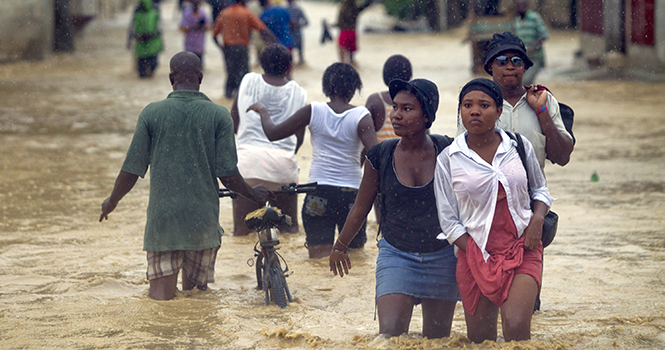Isaac leaves death, destruction in Haiti
Residents of Cite Soleil, Haiti, walk through flooding water that has taken over Route Neuf overnight, as Tropical Storm Isaac brought heavy rains and wind to the area, Saturday, Aug. 25, 2012. Photo courtesy of MCT Campus.
August 27, 2012
Jacqueline Charles
The Miami Herald
HAITI (MCT) — Before setting its sights on Cuba and South Florida, Tropical Storm Isaac left at least eight Haitians dead and cut a path of destruction through Jacmel and other southeastern Haitian cities, toppling billboards, partially collapsing roads and burying fruit trees in muddy flood waters.
Residents in this lush, seaside village remained without power and cut off from neighboring mountain hamlets Sunday as the rains from Isaac finally subsided.
“Look at it,” farmer Estlange Cherry, 21, said pointing to his family farm where his father-in-law was clearing away fallen plantain and breadfruit trees. “Everything is gone. We weren’t able to save not one tree. The flood waters from the river even took our pregnant goat.”
In rural Haiti, livestock is cash in the bank and farmers’ harvests are often the only way to pay for medication, food and children’s education. In addition to the loss of crops, residents in rural Jacmel remained cut off from others in neighboring mountain towns.
The Fesles Marigot Grand River washed away a huge chunk of a road bridging Jacmel and several mountaintop villages.
“This is something that is terrible,” resident Bellande Sanon said, standing on the river’s edge as public buses, known as Tap Taps, were forced to turn back. “Every area on the other side of this river will suffer. These are the areas that provide the most food in the region. Now, hunger will increase.”
In 2008, after four back-to-back storms battered Haiti and the river cut off access to villages, dozens of children became malnourished and some even died.
“Every time government authorities opt not to address the problems of this river, the region will suffer,” Sanon said.
George Ngwa, communications manager for the United Nations’ Office for the Coordination of Humanitarian Affairs, said the southeastern region received the brunt of the storm and farmers have lost beans, plantains and other crops.
“Coming after the drought in the north, we are worried it’s likely to have a negative impact on food security,” he said.
On Sunday, 17 damage assessment teams fanned out to assess loss of crops and homes throughout the country where 390,000 quake evacuees remained under tents in the quake-battered capital. Those killed in the storm included a young man who was covered in a landslide in DonDon, a town in northern Haiti, and a 10-year-old girl who was killed when her home collapsed north of Port au Prince.
The number of deaths could increase as reports from around the country are finalized. The number of storm evacuees, which more than doubled overnight, was in dispute Sunday.
The International Organization for Migration evacuated 1,000 people before the storms.
On Saturday, Civil Protection announced that 5,000 were in shelters and on Sunday the numbers had increased to 14,000. Across the border in the Dominican Republic, two people were confirmed dead and 12,889 people continued to be evacuated from their homes, the Center for Emergency Operations reported. The storm damaged 864 homes, including 51 that were destroyed, the government said.
The Dominican government kept ports closed Sunday and warned residents to stay off beaches. Authorities have detained at least 40 people near Santo Domingo’s boardwalk for failing to evacuate the area, local media reported. Authorities were still cleaning up debris left behind by Isaac and trying to restore power and telephone lines to at least 90 communities that are still cut off.













